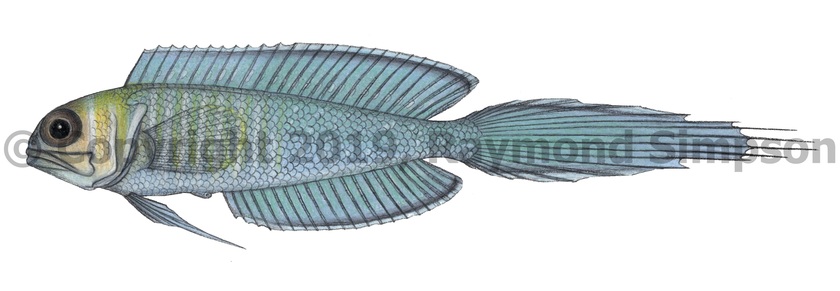
Common Name
Swordtail Jawfish
Year Described
Poey, 1860
Identification
Dorsal Fin: X-XI, 16-19
Anal Fin: III, 14-18
Pectoral Fin: 17-20
Gill Rakers: 45-65 total on first arch
Vertebrae: 10+17-19 caudal
Lateral Scales: 46-59
Body elongate, gracile and compressed (characteristic of Lonchopisthus). Body tapers toward tail. Head large and round with a very large eye. Maxilla extends past eye and has a strong concave rear margin forming a distinct hook. Dorsal fin long with no notch between spiny and soft portions. Pelvic fin short (up to 33% SL) with first two rays thickened and unbranched and last three rays branched. Caudal fin lanceolate with central rays filamentous. No branched caudal rays. Body scaled. Cheek and opercle with 4-6 scale rows. Lateral line ends under junction of soft and spiny dorsal fin.
Color
Body dusky yellow to bluish with several pearly blue bands on side and many pearly spots anteriorly. Head with pearly bands behind eye. Head dusky yellow with a darkened area between eyes. Eye dark. Dorsal and anal fin bluish with a thin blackish subterminal margin and a blue edge. Pelvic fins blue. Upper and lower caudal margins with blackish edging. Mouth membranes blackish.
Size
Maximum size to 101mm SL.
Habitat
Found mostly in shallower water (8-98m) but some records from deeper than 100m. Inhabits burrows in soft bottoms.
Range
Widespread in the Gulf of Mexico from Florida and Cuba to the Yucatan Peninsula. Also from Puerto Rico to the Lesser Antilles and from Panama to French Guiana.
References
Smith-Vaniz, W.F. & S.J. Walsh. 2017. Revision of the jawfish genus Lonchopisthus with description of a new Atlantic species (Teleostei: Opistognathidae). Journal of the Ocean Science Foundation, 28, 52-89.
Other Notes
Unique in having filamentous caudal fin rays that are entirely unbranched.